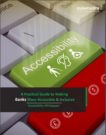The number of digital accessibility lawsuits filed in federal court under Title III of the ADA each year has been on the rise since 2017 – increasing by 184% from 814 lawsuits in 2017 to 2,314 in 2018.
In a high-profile lawsuit last year, Guillermo Robles sued Domino’s after being unable to make an order on the fast-food giant’s website and mobile app despite using a screen reader.
Robles’s lawyers argued in court that the Americans with Disabilities Act mandates businesses with physical locations to make their websites and other online platforms accessible to people with disabilities.
The ruling came down in the blind plaintiff’s favor with the judges declaring the “alleged inaccessibility of Domino’s website and app” unlawful and that it “impedes access to the goods and services of its physical pizza franchises — which are places of public accommodation.”
This lawsuit was one of 2,235 accessibility suits filed last year in federal courts, according to UsableNet.

Source: UsableNet ADA Website and App Lawsuit Recap Report
A majority of companies were sued more than once in 2019 further emphasizing the need to act fast in the event of a lawsuit.
This may not come as a surprise but Retail and Food Service companies were targeted the most last year due to the underlying challenges in becoming fully WCAG compliant as these companies often have a sprawling online presence. Companies with multiple brands and/or websites and apps need to be extra vigilant as they are the ones at the receiving end of these lawsuits often.
Here are three tips to help organizations steer clear of accessibility lawsuits:
1. Fix the nuts and bolts with the help of a testing tool
For businesses that recently renovated their website, redesigning their web pages all over again to ensure web accessibility can seem a bit excessive. But many of the websites facing accessibility issues more often than not lack the same elements, and fortunately, these are relatively easy to fix. There are plenty of automatic testing tools in the market that are quite adept at bringing these problems to light. These problems, for the most part, can be fixed by just inserting the missing string/text.
Websites in legal trouble are usually fraught with these three anomalies:
- No alt-text for images or infographics
- Broken links without text
- Redundant links
2. Be Proactive and Consistent
The court ruling in the landmark Haynes vs Hooters of America case (2018) is testimony to the fact that a business can be held accountable even when they are in the process of revamping their website to make it accessible.
In this case, two plaintiffs sued the famous restaurant chain and the company settled with one of them. The settlement agreement mandated that Hooters make their website comply with the WCAG 2.0 A/AA guidelines and to continually monitor compliance with WCAG 2.0. These were the same two remedies that the second plaintiff also sought in their complaint. As expected, Hooters then moved the court to have the second case dismissed, claiming that it was mooted by the settlement in the first case.
The argument worked at the district court level but was reversed on appeal. The 11th Circuit Court of Appeals announced that since the defendant could not show that the website was already in compliance with WCAG 2.0, the court would entertain the second plaintiff’s case.
Therefore, the fool-proof way to avoid an expensive lawsuit is to be proactive. Test the website early, fix potential problems, and keep testing the site regularly to ensure it remains accessible even as incremental changes are made every once in a while. Just as one wouldn’t open a store or restaurant before making sure it’s accessible to all its patrons, it goes without saying that websites and other online platforms need that same level of diligence as well.
3. Embrace Web Accessibility
Businesses ranging from retail to real estate have tried to circumvent web accessibility requirements but without any luck. The argument that the business does not operate in a physical location and therefore is not legally obligated to make its website accessible, or that the website does not contribute to revenue generation, will not hold water in a courtroom.
Take, for example, the National Association of the Deaf (NAD) vs Netflix case (2012). The charge leveled against the streaming giant was that it violates the Americans with Disabilities Act (ADA) by not providing closed captioning for most of its ‘Watch Instantly’ movies and TV shows. Arlene Mayerson, Directing Attorney of the Disability Rights Education and Defense Fund, one of the law firms that represented the plaintiff in this case had remarked that “there is no excuse for Netflix to fail to provide captions so that deaf and hard of hearing customers have access to the same movies and TV shows as everyone else. Mayerson went on to add that “for people who are deaf and hard of hearing, captions are like ramps for people who use wheelchairs.”
Netflix finally settled the case by agreeing to incorporate 100% closed captions in all of its on-demand streaming content within the following two years.
The laws surrounding digital accessibility can seem daunting at first. Although there is not a clear-cut federal ruling yet, a growing number of state cases indicate that ADA regulations apply to websites in addition to physical facilities. The National Federation of the Blind (NFB) and Heidi Veins vs Scribd case (2015) clearly illustrates the above point.
The lawsuit slapped on Scribd pertained to its ‘Netflix for books’ membership program, which allowed subscribers to read eBooks from its library for a small monthly fee. The plaintiffs alleged that “because Scribd’s website and apps are not programmed to be accessible through [screen reader] software, Scribd is denying blind persons access to all of the services, privileges, advantages, and accommodations that Scribd offers and is excluding them from accessing information critical to their education, employment, and community integration.”
Despite the Department of Justice delaying formal regulations, such lawsuits have become common of late with the plaintiffs winning most of these cases.
As is clear from the above examples, organizations would save a ton of time, money, and energy — and possibly enhance their brand image — by simply making their website accessible, instead of trying to devise a workaround to avoid litigation.
Conclusion
Thus, to ensure digital equity and avoid protracted legal battles, make accessibility a company-wide priority in 2021. Simply making the attempt to fix the website will not keep lawsuits at bay. Until and unless the site is made fully accessible, the danger of litigation will loom large. An inaccessible website can limit users with disabilities the same way a stairwell at a hospital is an obstacle to someone in a wheelchair. Organizations should shift their focus from how to evade this obligation to how to implement it to perfection. Plus staying on top of it will guarantee they never have a run-in with the law ever.
- Charting Your Accessibility Journey in the State of Illinois - December 6, 2021
- Demystifying Document Accessibility: 10 Tips to Help Get you Started - November 3, 2021
- Looking Back at Digital Accessibility and Its Significance Today: Timeline of Consequential Events - October 21, 2021



